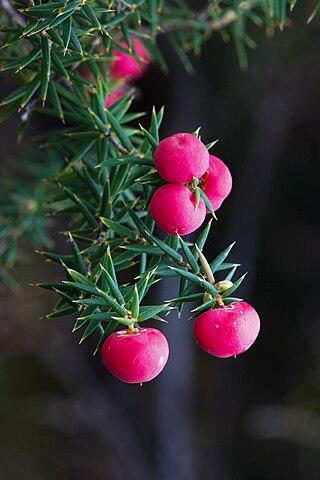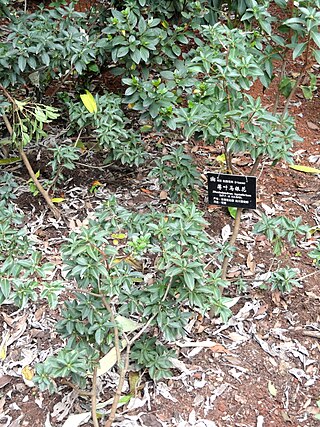Related Research Articles

The Ericaceae are a family of flowering plants, commonly known as the heath or heather family, found most commonly in acidic and infertile growing conditions. The family is large, with c. 4250 known species spread across 124 genera, making it the 14th most species-rich family of flowering plants. The many well known and economically important members of the Ericaceae include the cranberry, blueberry, huckleberry, rhododendron, and various common heaths and heathers.

Rhododendron is a very large genus of about 1,024 species of woody plants in the heath family (Ericaceae). They can be either evergreen or deciduous. Most species are native to eastern Asia and the Himalayan region, but smaller numbers occur elsewhere in Asia, and in North America, Europe and Australia. It is the national flower of Nepal, the state flower of Washington and West Virginia in the United States, the state flower of Nagaland in India, the provincial flower of Jiangxi in China and the state tree of Sikkim and Uttarakhand in India. Most species have brightly colored flowers which bloom from late winter through to early summer.

Cassiope is a genus of 9-12 small shrubby species in the family Ericaceae. It is the sole genus in the subfamily Cassiopoideae. They are native to the Arctic and north temperate montane regions. The genus is named after Cassiopeia of Greek mythology. Common names, shared with several other similar related genera, include heather and heath. They have scale-like leaves lying against the stems, and produce solitary bell-shaped flowers in late spring. Though hardy, flowers can be damaged by late frosts.

Ledum was a genus in the family Ericaceae, including 8 species of evergreen shrubs native to cool temperate and subarctic regions of the Northern Hemisphere and commonly known as Labrador tea. It is now recognised as a subsection of section Rhododendron, subgenus Rhododendron, of the genus Rhododendron.

Rhododendron groenlandicum is a flowering shrub with white flowers and evergreen leaves that is used to make a herbal tea.
Rhodora was a section of subgenus Pentanthera in the genus Rhododendron, that has since been discontinued. It comprised two species, both deciduous shrubs native to eastern North America:

Rhododendron subgenus Rhododendron is a subgenus of the genus Rhododendron. With around 400 species, it is the largest of the eight subgenera containing nearly half of all known species of Rhododendron and all of the lepidote species.

Rhododendron subg. Hymenanthes is a subgenus of the genus Rhododendron, with a widespread distribution in the temperate Northern Hemisphere. The species are evergreen shrubs and small to medium-sized trees, with medium-sized to large leaves. The flowers are large, produced in terminal trusses of 5-40 together.

Menziesia was a genus of flowering plant in the family Ericaceae. More recently it has been reclassified within the genus Rhododendron. it was formally transferred in 2011.
Lyndley Alan Craven was a botanist who became the Principal Research Scientist of the Australian National Herbarium.

Rhododendron section Tsutsusi was a subgenus of the genus Rhododendron, commonly referred to as the evergreen azaleas. In 2005 it was reduced to a section of subgenus Azaleastrum. Containing 80 - 117 species, it includes both deciduous and evergreen types and is distributed in Japan, China and northeastern Asia. They are of high cultural importance to the Japanese. Among the species in this genus lie the largest flowering azaleas.

Rhododendron section Vireya (vireyas) is a tropical group of Rhododendron species, numbering about 300 in all. Vireyas are native to southeastern Asia and range from Thailand to Australia.

Rhododendron columbianum, commonly known as western Labrador tea, swamp tea, or muskeg tea, is a shrub that is widespread in the western United States and in western Canada, reported from British Columbia, Alberta, Washington, Oregon, Idaho, California, Montana, Wyoming, Utah, Nevada, and Colorado. It grows in wet places from sea level up to 3,500 m (11,000 ft). It was formerly known as Ledum columbianum. Its origins date back to the late Pliocene.

Rhododendron subgenus Azaleastrum is a subgenus of the genus Rhododendron.

Ericoideae is a subfamily of Ericaceae, containing nineteen genera, and 1,790 species, the largest of which is Rhododendron, followed by Erica. The Ericoideae bear spiral leaves with flat laminae. The pedicel is articulated and the flowers are pendulous or erect, and monosymmetric, with an abaxial median sepal. The carpels are free and the anthers lack appendages. The capsule is septicidal.

Rhododendron subg. Choniastrum is a subgenus of the genus Rhododendron, originally a section of subgenus Azaleastrum it was elevated to subgenus rank after cladistic analysis revealed that together with Rhododendron it formed a major clade, distinct from other sections of Azaleastrum.

Rhododendron subsection Brachycalyx is a subsection of the genus Rhododendron, in section Tsutsusi, subgenus Azaleastrum, consisting of fifteen species of Azaleas from Asia.

Rhododendron subsection Tsutsusi is a subsection of the genus Rhododendron, in section Tsutsusi, subgenus Azaleastrum, consisting of 66 species of Azaleas.

Epacridoideae is a subfamily of the family Ericaceae. The name StyphelioideaeSweet is also used. The subfamily contains around 35 genera and 545 species. Many species are found in Australasia, others occurring northwards through the Pacific to Southeast Asia, with a small number in South America.
References
- ↑ Craven, L.A. (April 29, 2011). "Diplarche and Menziesia transferred to Rhododendron ( Ericaceae )". Blumea - Biodiversity, Evolution and Biogeography of Plants. 56 (1): 34. doi:10.3767/000651911X568594. ISSN 0006-5196.
- 1 2 "Kathleen Kron". WFU Biology. Archived from the original on March 13, 2016. Retrieved March 13, 2016.
- ↑ "Undergraduate College | Teacher-Scholar Legacies: Kathleen Kron". July 13, 2021. Archived from the original on July 13, 2021. Retrieved October 26, 2021.
- ↑ "Ericaceae Homepage". Wake Forest University. Retrieved March 13, 2016.
- ↑ Craven, L.A. (April 29, 2011). "Diplarche and Menziesia transferred to Rhododendron ( Ericaceae )". Blumea - Biodiversity, Evolution and Biogeography of Plants. 56 (1): 33–35. doi:10.3767/000651911X568594. ISSN 0006-5196.
- ↑ "Labrador Tea, Ledum groenlandicum, Rhododendron groenlandicum". www.friendsofthewildflowergarden.org. Retrieved October 26, 2021.
- ↑ "Kron, Kathleen Anne | International Plant Names Index". www.ipni.org. Retrieved October 26, 2021.